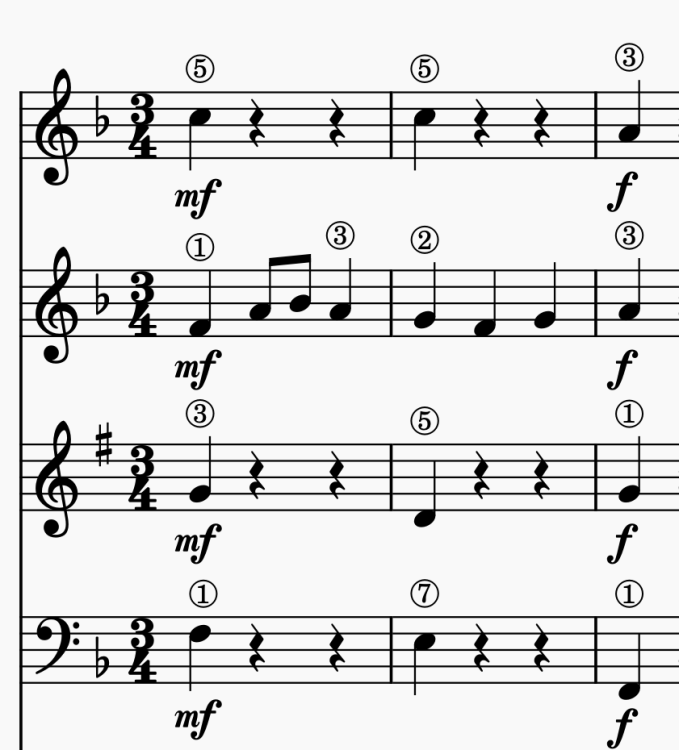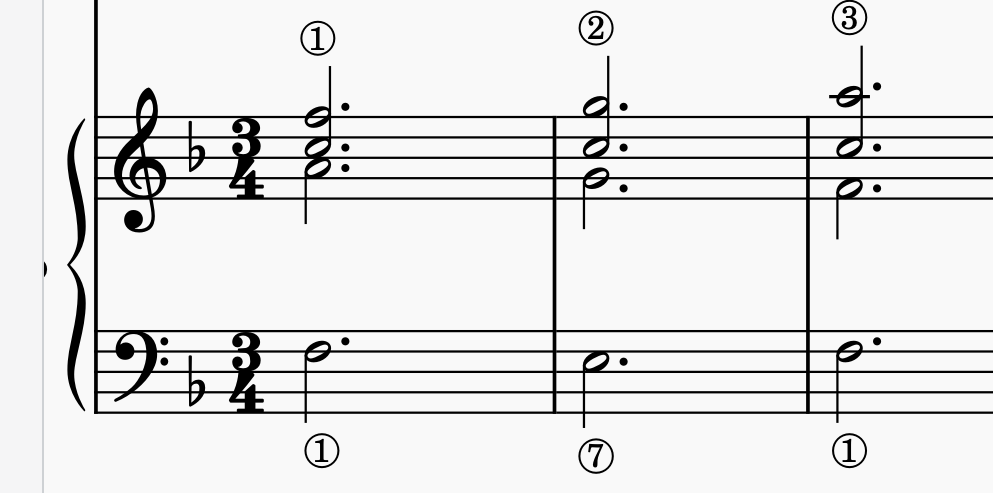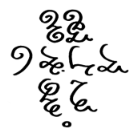Leaderboard
Popular Content
Showing content with the highest reputation on 02/25/2025 in all areas
-
This is intended to be the second part of the second movement of my String Sextet in G flat major, after the part of Lamentoso. These two parts are very different from the more fleeing and transcendental first movement as I hope they capture the sadness of the time and what I feel, before leaping back to the world of the pentatonics later, which would make the pentatonics more grounded. Here is the first movement of the piece: Here is the first part of the second movement of the piece, the Lamentoso, which is actually finished after this fugue: Here are the scores, the original version and a version with my own (painful) analysis on it: Final Fugue from String Sextet movement 2.pdf(With Analysis) Final Fugue from String Sextet movement 2.pdf And here is the youtube video: The piece is dedicated to Mr. Johnson Ho. The finishing of the fugue is prompted by hearing his worsening health, so I really want him to stay healthy. The inspiration of the fugue first comes from my friend Mike @chopin and my mentor David (I am very honoured to name him my mentor even though we have never met in real life since his videos form the skeleton of my composing skill. Go watch his analysis videos NOW!) said that the middle fugato section from the first movement is the best part of the movement. I was shocked since I believed it was the worst of the movement! Then my bro Vince @Thatguy v2.0 (who also makes this perfect audio) inspired me to write a dense fugue for the second movement, and so I challenged myself to write a six part fugue, since I feel like it’s not fully realised in the first movement. This is he most difficult I have ever written, but finishing it I now consider it my most beautiful work composed up to date. It’s so emotionally deep, even weirdly I feel zero emotion during the composition process, only calculating the counterpoint haha. I am so satisfied with the result. The fugue comprises of three subjects, all from the 1st movement. The 1st and 2nd subjects are from the 1st movement fugue’s subject, while the 3rd subject is derived from the opening theme of the Sextet’s first movement. Here is the plan of the movement (time according to youtube video): First part (00:03): First subject enters in each instruments, inversion introduced at . All of sudden C minor enters (01:55) and I quote my subject of the C minor Clarinet Quintet 3rd movement fugue here to intensify the sadness. Also kind of replying to the relationship of G flat major and C major in the first movement, but while freedom is shared there, now sadness is shared. Second Part (02:12): Second subject enters and the section features a saturation of stretti. The C minor section (03:56) comes in at and it’s my favourite section of the whole fugue. It’s insanely tragically beautiful here. Third Part: Third subject enters (04:58), first and second subjects combine in the manner of the 1st movement fugato. The intensity is kind of lowered after that insanely tragic C minor section, maybe kind of accepting and reflecting upon it, and it’s less saturated with the subjects. However things starting to get intensified, first the third subject is treated as in Bach’s Chorale Preludes when it is cut up and divided to four phrases alongside the other two subjects (06:29). The only pentatonic entry (07:16) arrives to kind of relate itself to the first movement and hints what will come at the end, but at the meantime it’s defeated by disappointment and the fugue ends in a doubtful manner, which will lead to the chant section. Hopefully I would finish the whole movement as soon as possible! Hope you enjoy the fugue now! Henry2 points
-
[ 2-28-25: EDIT: ADDED CORRECTED 1ST MVMT TO THIS POST FROM LATER IN THREAD....] At long last I've gotten my Piano Quartet 1st movement into a near- final form. There are details that need attention, but I think it is time to hopefully get some feedback. It took a while--my father developed severe alzheimers, we had to move them, sell their home... And then my mother passed---who gave me my love of music. Composing has helped me commune with her..... *************************************************************************************** A Brief summary of the 1st mvmt: This is in classical sonata form: exposition, development, recap with a brief coda. Exposition: 1st theme in C minor, 2nd theme in F major, return to 1st theme and codetta Development: A: Development of 2nd theme into minor, some diminution of the theme, and looser feel B/C: Introduces a third theme, in 4/4 time a major key inversion of 1st theme turned into a Mendelssonian chorale w/ piano, leading as an intro to... A fugato passage based on the 1st theme regularized in half notes in A minor (4/4 time) Coda transforms back to 6/8 and C minor... Recap: Return of 2nd theme in Eb major (instead of F) 1s theme in strings and them a grand statement w/ piano, joined by string to finish. Coda: Introduce another complimentary motif/new material manipulating main theme to close on strong cadence. ************************************************************************************************** I generally like it, but working with recap textures/thinning and trying to abbreviate for the sake of momentum might be something I look at. The FUGATO passage is my first, and was hard won. I think it works. I learned a ton working on this piece. Third movement Rondo in C minor next... (I include an MP3 of the second movement (PQ Mvmt.II VSL WS MASTER), using the new very expressive Vienna Symphonic Library Synchron solo violin... )1 point
-
My advice would be to write music as if it were not just a conversation but a debate and, at times, and argument! A convincing narrative that can capture the listener will flow between states of tension, release and fundamental questions. You might wonder how this will help with the technical side of achieving this. And you’re right, it’s not easy. It takes me a lot of time. However, I don’t personally begin the process on a technical level. I just let the ideas flow and worry about the embellishments later. And you can work that out one way or another with determination. I hope that helps.1 point
-
I was trying to imply that the larger scale a work the more intensive the constructive feedback process becomes. There is just so much to look at here. For what it’s worth, I felt that the minor mode could have been balanced a little more with the major mode in the first movement for better contrast. I listened to the movement again and there are only isolated and short lived instances of modulation to a major key. Not all music needs to be happy, of course… but there should be some form of hope that the listener is bound to. And that comes a little late with the second movement. Gorecki’s symphony of sorrow comes to mind… or Mozart’s great mass in c minor , in which the soprano in the opening movement features provides immediate relief from the otherwise ‘dire’ mood. That is all I can really constructively say without looking at the music in great detail. 🙂1 point
-
Wow, @Rich. This is an immense work. It is difficult to provide constructive feedback on something with such depth. I would, though, like to hear more about your influences for this work. Who are your role models and the style you are emulating? Markus--- Thank you for your comments. I don't know how much depth it has!---but I did shoot for coherence and a logical form. I must admit I am proud of it as far as thematic unity--melodic and rhythmic motivic fragments help to unify it--the opening, the three sections of the developments, and even in the coda. I really just had to trust our great teachers from the past and put as much craft into it as I could. And, I know, my mom's passing fueled what feeling made it into the later portions.. I started the 1st mvmt looking to Mendelssohn and Ferdinand Ries(Beethoven's pupil and friend, and a fine composer himself)--definitely "early" romantic composers, but looked and listened to a lot of Schumann and even took to Brahms' own PQs as time passed. I think the basic musical language is early romantic--thematic vs. motivic development, clear diatonic harmony. The "quiet" interior of the piece--the chorale--is my take on Mendelssohn invention he used in developments and caught on. It worked back in the 1830/40s because it was new--- instead of amplifying as in classical development, you take a step down before a more energetic close to the development (here the fugato). More generally, I love late Schubert- the piano trios and quartets. Spiritually, he has to be an influence. The rest, I guess, is me. My own criticism of the piece is an overly formal statement of themes. The hardest portion to write was the "A" section of the development, as chopping up and playing with fragments requires the most work, musical sensitivity,and skill---rapid modulations, changes of rhythmic patterns/motifs, etc... I defintely want to focus on this more on my next piece--a violin sonata (to be written on Dorico for the first time!). ****************************************************************************** The neat score is due to my pianist holding my feet to the fire--as I asked her-- to produce a clean, usuable score/parts for performers--a new consideration! She has been great. And thanks, it took a lot of work and time!---and I'm not done! Anyhow, I just signed on my string trio, and am mentally juggling a rondo theme around in my head, almost ready for pen and paper. I would like to have it done by early may and in my pianists hands --she needs 4 or 5 weeks to work on it-- for a June workshop. I've never worked like this--with a deadline of sorts--and it is a bit unpleasant! If I blow by this deadline, my group has to bring on a new violist---a little hickup. I told them I'm not going to botch it up just to have it done, however... I want it to be fitting for the piece as a whole and tie it together style-wise. I'm thinking of a call back of the chorale from the 1st movement in the coda, and a major key ending, honoring my mother, and wishing her peace.... Mainly, I need about 50 hours uninterrupted work time!! Fat chance of that.... Thanks again for your kind words and interest! You are a fine composer, and your thoughts have weight! My life is a bit like an American country music song right now, and this gives me a real lift!1 point
-
This is a symphony I completed yesterday, Christmas Eve. I had already published the first movement a few weeks ago and wished to share the other now-complete movements. The symphony follows the standard four-movement classical structure, however, I do have some doubts in this topic. For example, I added repetitions to both the (exposition) and (development+recap.) sections in the first movement, but noticed that Mozart himself normally doesn't add repetitions on the (development+recap.). Maybe this lead to excessive thematic repetition in the first movement, please tell me what you think! Also, regarding the last movement, I wrote a rondo even though I don't think Mozart's 4th movements from symphonies are strict rondos. Maybe I should have written the 4th movement in sonata form? One last thought regarding key: I opted to write dominant sections in Db major instead of C# major to facilitate performance (for example, the Minuet). Was this good practice, or would it be best to keep the dominant as C# Major regardless? Looking forward to your feedback!1 point
-
Wow, @Rich. This is an immense work. It is difficult to provide constructive feedback on something with such depth. I would, though, like to hear more about your influences for this work. Who are your role models and the style you are emulating? It sounds to me like something from the middle-late romantic period and, admittedly, that is not my niche! The engraving is also impressive.1 point
-
Like many trio sonatas, this work consists of four movements: slow - fast - slow - fast. It starts with a three-partite Grave with a slight hint of French ouvertures, though then developing in a different direction. The second movement is a fugue. I am rather fond of a moment where all voices stop and the recorder and violin start the conversation of voices anew, and more lucid than before. The third movement is a through-composed Adagio, followed by a fugal finale in 12/8. This trio sonata is written for alto recorder, violin, cello and harpsichord, but a variety of instruments would fit too, though it leads to interesting changes in the character of the individual movements. I am not sure if the Grave and the Adagio shouldn't be swapped to increase the coherence of the music. Any suggestions welcome.1 point
-
I promised I would have a little look at your piece in detail. So here goes... I didn't wish to interfere with your melodic writing so have focused on providing input regarding voice leading principles. Let's look at the opening motif... (The numbers I have entered above the notes below indicate their scale degree and this useful for voice leading analysis). A) In this opening, the bass features scale degrees 1-7-1. This pattern is typically used to accommodated a higher voice ascending from 1-2-3 respectively, while other voices may descend from 3-2-1 or maintain a pedal on scale degree 5. The melodic line in this example (oboe) emphasizes scale degrees 3-2-3, which is a non-standard solution on the basis that this would lead to consecutive with 3-2-1 part as well as a possible ascending (1-2-3) line. It would make more sense to close the melodic line on scale 1 (F natural) to to accommodate the contrary motion that makes this opening gambit effective. Notice that the voice leading for your clarinet line is not smooth as a result of this configuration. In these situations, it is desirable to facilitate stepwise motion between the individual parts opposed to leaping about; if you are leaping around excessively, it suggests the voice leading could be improved. Finally, the bass returning to F in bar 3 doesn't need to drop to the lower octave, and the flute part can remain on scale degree 5 due to the doubling of the third being unnecessary. Here is how the voice leading could be realized, which as you can see consists of oblique, contrary and parallel motion with no consecutive 5ths/8ves B) The other example I want to use is the nice melodic line from bar 11. It is quite beautiful. However, the other parts are a bit muddled. Let's isolate this part with the bass alone to see what's going on... In several places the bass part clashes with the melodic line, especially at the end cadence. There are also consecutive octaves in one or two places. I have realized an alternative bass for you to have a look at and compare. Note that I look for opportunities for contrary motion wherever possible, while retaining the strength of the chord that is being realized (for example, avoiding doubling the outer voices). It is good practice to avoid doubling the bass and main melodic line in the interest of maintaining independence. You can double with inner, supportive parts more freely. I have provided an audio of our respective realizations... Here is my realization If I evaluated all aspects of your piece in this manner I'd spend a whole day doing so! So I will stop here. But I hope you can appreciate the importance of effective voice leading in your work. Always consider the outer voices in first instance to arrive at a coherent skeleton that can then be embellished by filling out the inner or supportive elements. If you have not yet read Robert Gjerdigen's 'Music in the Galant Style', I would recommend doing so for further voice leading instruction and especially if you like the galant style. This wikipedia page can provide an introduction to the analytical system that he advocates using (schema theory): https://en.wikipedia.org/wiki/Galant_Schemata Feel free to ask any questions.1 point
-
You're right, I wanted here a French song spirit, maybe the beginning of the century.And musically, I wanted to try to install this contemplative climate. The means are therefore very scarce on purpose. It's really nice that you talk about Rachmaninov because I recently had the immense privilege of singing again with the choir for whom I work the fabulous vespers. It's so beautiful, inevitably it leaves its borrowing...1 point
-
Oh, thank you again, Yes, it's a disillusioned love song. The poet regrets that the loved one is ultimately not attentive to him other than by frivolous play. He generalizes and his words might seem bitter to us towards women if he did not mock himself. It's all the art of Jules Laforgues, to know how to tell us both the sublime and the ridiculous, the irony and the metaphysical aspiration... He is a great poet too unknown in France, who died at the age of 27 of tuberculosis in 1887.1 point
-
Thank you very much! The female rhyme in French poetry is a verse that ends with a silent E, that is to say that we do not pronounce and therefore a foot that is not counted in the metric. In singing we can pronounce it because the sung declamation is of a different nature, but it necessarily implies a particular (désinence) treatment of the tonic accent in ending.1 point
-
I think "narcissism" is inherint in all true creative endeavors--insofar as we have to turn inward to produce something new. Officially, Narcissism-- as a personality disorder means a chronic problem with human relationships. We stray from "self-absorption" or inward focus into trouble when we can't interact with others in a healthy fashion--see them as individuals. Read the biogrpahies of many great composers, painters, writers--and you see the conflict between artistic vision and relating to the outer world and the people in it. It's a factor that I think all creative people should be mindful of. We need people. They also need us. Learing to balance that is the trick.1 point
-
I really like the instrument; it's beautiful—its sound and the music. I found the Pavane somewhat livelier than I expected.1 point
-
Hi @JorgeDavid, I quite enjoy this one with the simple but sorrowful melody. The mood is portrayed well with the simple prelude E minor like accompaniment as mentioned by @PeterthePapercomPoser too. Thx for sharing. Henry1 point
-
What a lovely piece! You nailed it with the title - although there were some slightly brighter moments, the piece has an overall lamenting tone. I've heard a LOT of compositions where just because the piece was in minor, the composer expected a "sorrowful" or "somber" tone, yes the overall sonority of minor keys tends to be more somber, I believe, if arranged correctly, even major keys can have a melancholic tone to them - BUT, that's a discussion for another day. One thing I enjoyed about this piece is that it sounds more modern without sounding too modern. I'm not sure if that makes any sense lol. Your phrasing is another one of the things you've done so well with this piece. I don't always hear NT and PT and stepwise, scalar motion being used in such a sophisticated way. I like the leaps, they added brightness, while maintaining the shape of the melody. Your harmony is simple, but I'm a sucker for i-iv-V7-i in minor 😂. Overall this piece is very strong - I don't have much more to add that hasn't already been said. I know you have more material in you, I can hear it 👀 As a pianist-composer myself I understand the struggle to balance composition with practice and such - BUT, I would love to hear this piece orchestrated. Nothing too elaborate - maybe a wind quintet with a flute on the melody, just a thought - a bass clarinet on the "tenor" and bass voices 😮💨👌🏾1 point
-
@JorgeDavid also to touch on arrangement, you don’t have to arrange a piece to be 100% like the original. And you don’t even have to publish it! but I’ll give you another example of something I arranged recently. I’m sure you know about the Halo Game franchise. I took the Halo 3 OST track “Never Forget” and completely overhauled it using the same instrumentation and same intervals of key changes using a different starting pitch, and added in my own styling, as well as combining elements from the Halo 3 version written by Martin O’Donnell and the Halo 4 version written by Kazuma Jinnouchi heres the Musescore Link to that one just to give you an idea about what I mean by arrangement. The possibilities are endless with things like that! You can MAKE it your own! Doesn’t have to be someone else’s from start to finish. One big aspect of music is the theft of ideas. It’s one of the fundamental parts of composition. Composers steal ideas and expand upon them all the time.1 point
-
It works with or without a subscription. You have to have internet connection to use the playback however. But if you have internet connection before launching the LABS plugin thru the mixer, it will work fine the rest of the time from what I’ve experienced with it so far. also Thank you for taking time to hear my piece. I know the engraving and grammar is a bit weird. That’s only because with a piece that size, my laptop kept freezing while doing anything by after a certain point so I just didn’t even bother going back to add in slurs, clean up staff text markings and other small things. If I were to receive a request to perform the piece, I’d probably go ahead and grit my teeth and get that over with but for now it’s just gonna have to stay that way 😅😅1 point
-
As implied by its title, this arrangement was based off my Crab Canon (aka. Canon Cancrizans) a 3 in C minor ( • Three-voice Crab Canon in B minor.): Since its initial publication, it has been transported one half step upwards to accomodate for the ranges of the instruments involved in this double trio, with the full realization played by the Continuo harpsichord part (which may be omitted entirely on account of the extremely wide intervals between voices in certain invertible configuartions making it rather difficult to play). Enjoy! YouTube video link:1 point
-
It's a lovely trio sonata. My favourite movement is the 2nd. The subject is interesting and your treatment of it is very successful throughout, with a well-planned structure. I would personally omit the re-exposition before the stretto entries, and expand on the stretto material - I think it's here a contrapuntal goldmine that is somewhat underexplored. But overall, the piece is rhythmically varied, motivically tightly-bound, idiomatic, harmonically consistent with the Baroque (I love the Neapolitan chord near the end!), and with well-written counterpoint throughout. For me, the biggest weakness I find is the lack of variety of form. The fourth movement is almost identical to the second from a structure PoV, and the third lacks a formal structure. Principles like binary/canon/ritornello/invention/gallant sonata are all reasonable tools to reach for that will make your movements have greater diversity and contrast. Writing the third movement in a major key helps too!1 point
-
Thanks for listening! I know what you mean about the NotePerformer output. I had to fiddle with the volume of the clarinet vs. the strings just to get it to sound like this, and there are still places where the clarinet gets too buried. I probably should have done more to mark the clarinet dynamics up.1 point












